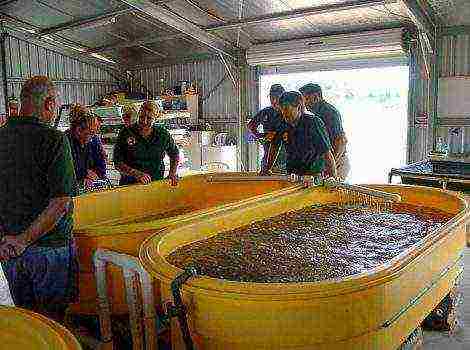By organizing fish farming in a pond, pool or cage method, the owner can sell an environmentally friendly product to the market at a high cost, and the suitable climate of our country and the growing demand for carp and trout make this business profitable and very profitable in all regions.
The content of the article:
- Fish farming methods in artificial conditions
- Features of breeding in artificial pools
- Common misconceptions of novice fish farmers
- Features of breeding in a pond
- Cage method
- What kind to grow?
- Carp breeding technology
- Trout breeding technology
- How much can you earn?
- Examples of successful "fish" business
For many millennia, the products of the world's oceans have been competing with livestock products. Many treatises have been written about the benefits of these products. The World Health Organization recommends eating fish at least 2 times a day. The content of specific fatty acids (Omega-3) in it has a positive effect on the functioning of the brain and heart. Vitamin D is essential for proper bone growth. The consumption of salmon, trout and mackerel is very important for the normal development of the fetus and is recommended for pregnant women and children. Fish farming in Russia is a fairly relevant line of business and is constantly evolving.
Fish farming methods in artificial conditions
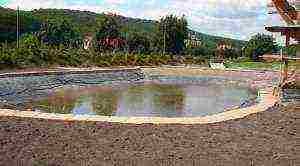
Business should be fun. Fish farming is best associated with relaxation and can bring a lot of pleasant emotions. Moreover, it is quite a lucrative and uncomplicated process. The arrangement of your farm does not require large investments, and the economic effect is quite tangible, and with proper housekeeping, you can get regular profits and an environmentally friendly product to your table. The demand for typical river inhabitants, be it sturgeon or trout, is constantly growing in Russia. A huge number of ponds, lakes and reservoirs, as well as the climate in our country make it possible to successfully engage in this type of activity in almost all regions. Artificial fish farming was practiced in ancient times. Currently, this method has reached a high level of development and provides for implementation in the following conditions:
- In the pool.
- In the pond.
- Cage method.
The guarantee of success in this case will be the preparation of a detailed business plan, taking into account many risk factors.
Features of breeding in artificial pools
The advantageous quality of fish reproduction in artificial pools is that it can be positioned absolutely anywhere. This can be a garden or another part of the infield. Another positive point is the ability to choose the volume, material and shape of the tank.Such tanks are very durable, as they are made of fiberglass, metal or reinforced concrete structures. They require minor maintenance work and do not need very frequent cleaning activities. If desired, you can order pools of any shape, which will allow you to install it based on the availability of free space. As a rule, the walls of the tank, made of various types of plastic, have a smooth surface, which prevents their significant contamination, reduces the cost of water treatment and the likelihood of a fish epidemic. The ability to artificially regulate the temperature and hydrochemical regimes makes it possible to use reservoirs of this type all year round.
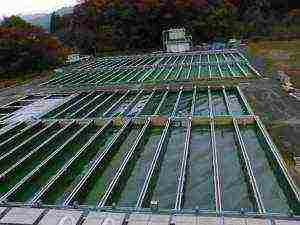
The installation of a closed water exchange, as the most advanced method of growing in artificial conditions, allows you to achieve complete mechanization and automation of processes. For the reproduction of fry in this way, it is best to choose gourmet varieties (sturgeon or salmon), since the installation of expensive cleaning and water exchange equipment increases costs by about 1.5 times. The saturation of the planting in such an environment is calculated based on the rate of water purification and its circulation. The fish productivity rate is from 20 to 100 kg per 1 m3. The method is simple, but there are typical mistakes when starting it.
Common misconceptions of novice fish farmers
- Large production volume. The growing technique is quite simple, but in the absence of experience in this industry and making elementary mistakes, you can lose the entire offspring at once. To begin with, you should master the first basics of this business and get positive results, and then move on to industrial volumes.
- Purchase of handicraft equipment. If you decide to equip the fry tank in compliance with all the rules and regulations, then you should work hard to purchase, if not the most expensive, then reliable equipment. In case of failures in the process of cleaning, oxygen enrichment or pumping water, the entire living mass of your pool can die and the costs will be colossal. The deal is profitable, but there is no need to rush and chase super-profits at the risk of all production.
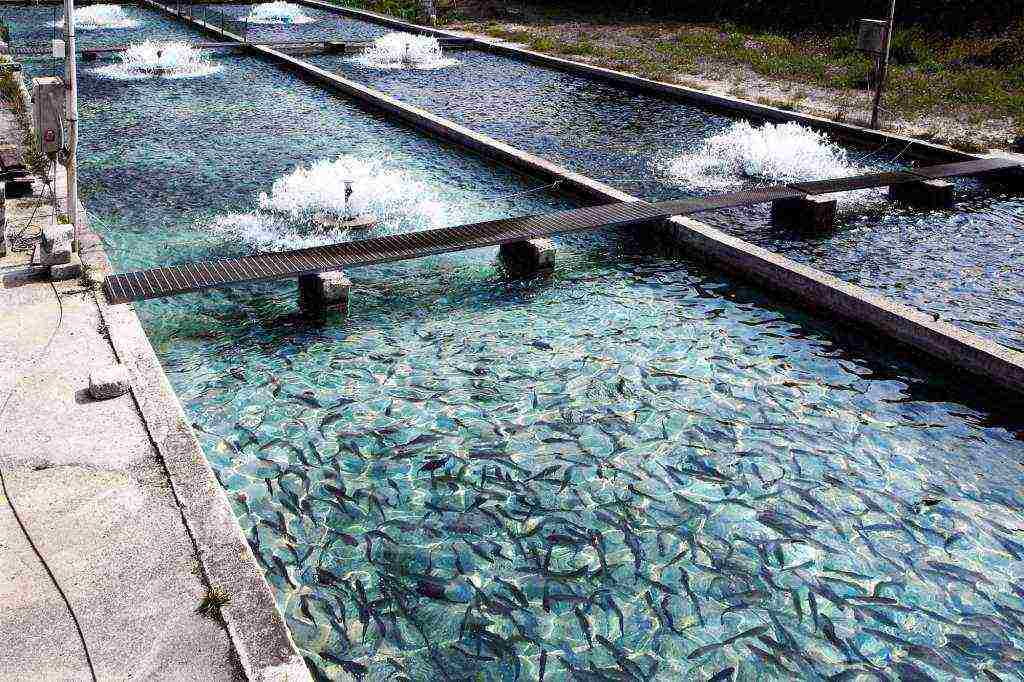
- Making a pool with your own hands. If you do not have experience in building a pool or you are not familiar with the basic principles of building such structures, then you should resort to the help of specialists, which, if done correctly, will, of course, pay off. And having spent a lot of money and nerves on the construction and having received a colossal fiasco, you can stop your commercial zeal.
- Poorly verified project accounting. Our man's hope for "maybe" never ceases to amaze and seemingly obvious things are not taken into account. Only accurate financial calculations of costs and profits, numerous consultations with experienced manufacturers and economists will help you avoid significant losses.
Features of breeding in a pond
This option is one of the least risky and is suitable for beginners. The minimum monetary threshold and the ability to use natural reservoirs without additional spending will allow you to get positive developments. On the territories of Russia, Belarus and Ukraine, you can easily find a suitable pond or backwater. There is an option with using your own artificial pond, which will force you to make additional investments in earthworks and has a certain risk associated with a lack of groundwater and critical shallowing of the pond. Also, to get a good profitability, you need a pond with an area of at least 1 hectare.
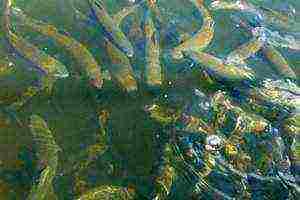
Cage method
Assumes a combined approach to reproduction. It has both positives. So are the negative qualities. Natural waters with certain instrumental support are used. To implement the method, you need to purchase or build your own floating cage and stock it with fry. Cage lines are installed in lakes, river backwaters or reservoirs.The latter method, provided that the environment is heated, makes it possible to obtain population growth all year round. The main advantages of a cage farm:
- Small area. Allows for better guarding of cages and simplifies fishing.
- Possibility of implementation all year round. Most companies have a seasonal sales vector. This advantage will increase your profits.
- You can use all types of pond, even for complex purposes.

What kind to grow?
Before starting a project, you should ask yourself what kind of fish you are ready to supply to store shelves. The main varieties for sale are carp and trout. Breeding, feeding and care techniques are somewhat different. Carp is a very unpretentious variety that can be placed in many types of water and used less specialized feed. There is a lot of information about the features of technology on the Internet and specialized manuals. Growing trout fry is a somewhat more laborious process. You need to have basic fish farming experience and special education. This variety is extremely picky about the place of keeping and conditions.
Carp breeding technology
This representative of the marine fauna occupies a leading position in this segment of the freshwater aquaculture market. For the growth of fry of this species, artificial reservoirs, ponds and the cage method can be used. The following breeds are grown:
- Scaly.
- Mirror.
- Linear.
- Naked.
- Ukrainian frame.
It is possible to cultivate carp in monoculture with various other species, including predatory breeds. There are three systems of reproduction:
- Extensive.
- Semi-intensive.
- Intense.
The extensive environment involves feeding carp with natural derivatives of the bottom fauna and zooplankton. The method is characterized by a small increase per unit area (from 200 to 650 kg). The advantage is low feed costs and costs.

The semi-intensive method consists in drawing up the diet in such a way that it contains more artificial feed, which is produced in significant quantities by the agro-industrial complex. The lack of calories in the diet is leveled with the help of food additives of the carbohydrate type (various types of cereals). With the correct selection of the ration, productivity reaches the level of 650 to 1400 kg per hectare. A clear advantage of this system is the ability to correct food energy deficiencies through supplementation.
The intensive system provides for the transfer of the entire generation to a complex feed that contains protein in high concentrations (up to 40%). The high value of nutrition leads to a large planting of the growth area, which requires additional aeration, if the norms are not observed, there is a risk of death of the offspring. The efficiency of this system makes it possible to receive from 5 to 20 tons per hectare of water area. A positive feature is the maximum utilization of water areas. However, there is also a significant risk of infection and epidemics.
Trout breeding technology
There are more than a dozen species of trout in the world's oceans. Two main ones are most suitable for industrial reproduction:
- Brown trout.
- Rainbow trout.
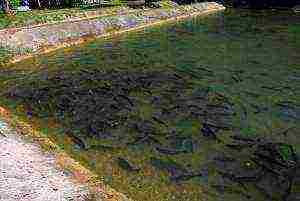
The first species grows in the waters of the Azov, Black, White and Caspian Seas. It has good taste and is one of the most valuable types of fish. It lives exclusively in cold conditions and requires a sufficiently high aeration. The rainbow trout grows in North America. It can live not only in cold streams, but also in warm rivers. Has excellent growth ability.
The cage method and the pond culture method are suitable for reproduction. However, trout does not breed in ponds and artificial insemination has to be used. You should adhere to the temperature regime from 4 to 18 ° C. It takes about 2 years to grow an adult ready for sale.
How much can you earn?
The expenditure and revenue side of the project will vary with the scale of production. The cost of carp fry varies from 60 to 120 rubles per kilogram. The minimum price of compound feed for him is 7-8 rubles. An adult is sold at 100-130 rubles per 1 kg. For example, you can take the average values of the main points when growing carp. With the most conservative calculations with minimal volumes of the final product, the cost part looks like this:
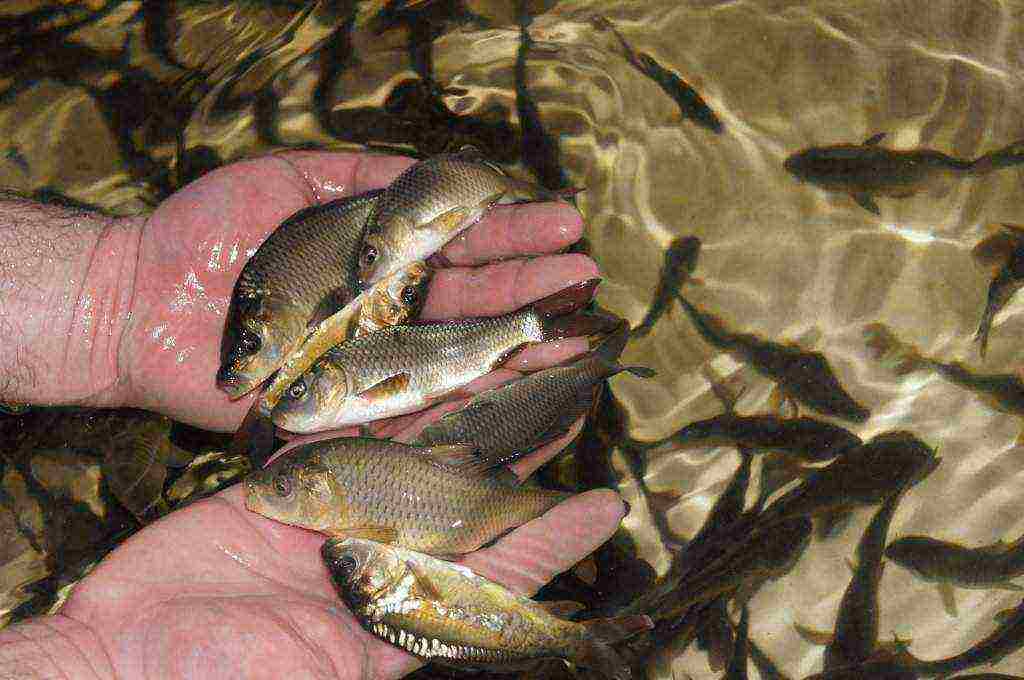
- Malek - 5200 rubles.
- Personnel - 15150 rubles.
- Food - 3350 rubles.
- Other - 9350 rubles.
The regressive part of the accounting will be 30,050 rubles.
With a total profitability of 50,000 rubles, the net profit will be 19,950 rubles. A multiple increase in parameters will lead to lower costs and higher profits. The profitability with the correct organization of the process can reach 40%.
Examples of successful "fish" business
Large holdings with a wide network of export links are engaged in the successful cultivation of fish on an industrial scale in Russia. However, small and medium-sized fish farms, which are successfully increasing production in Russia (OOO Arskiy Rybkhoz, OOO Vyvenskoye, OOO Nazarovskoe rybnoe khozyaystvo) deserve great attention. Such companies are an excellent example of a verified technological and financial basis for fish farming.
- Starting capital (from): 150,000 rubles
Related materials:
Fish processing, Fish trade, Crayfish farming
Business relevance
Today, fish products are in demand in the city's markets, not only of large enterprises, but also of small private farms. Breeding fish makes it possible to save precious time - you need to spend only 3-5 hours per day for their care. Having received knowledge in the field of fish farming and organizing a reservoir, you can have a stable and high income.
Farming fish in artificial reservoirs as a business has little evidence of the risk of bad weather or seasonality. If you organize your business correctly, you can quickly recoup your investment and achieve a stable income.
Related videos:
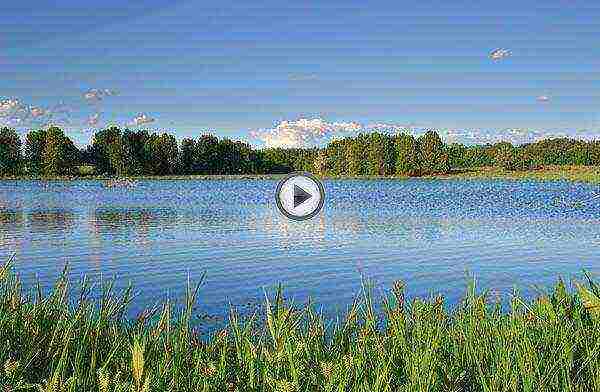
Tips for novice fish farmers
Development directions
At the present stage, fish farming is developing in several directions:
- Pond farming is the use of a separate reservoir for raising fish (suitable for a variety of species).
- Cage breeding of fish is important for large fish. The essence lies in the use of a part of the river, lake, reservoir, dividing the water space with cage lines.
- The basin method consists in raising fish in artificial reservoirs. Suitable for breeding pike, salmon, bream, perch, carp, etc. Some entrepreneurs create mini-reservoirs, which are low barrels or baths.
Related videos:
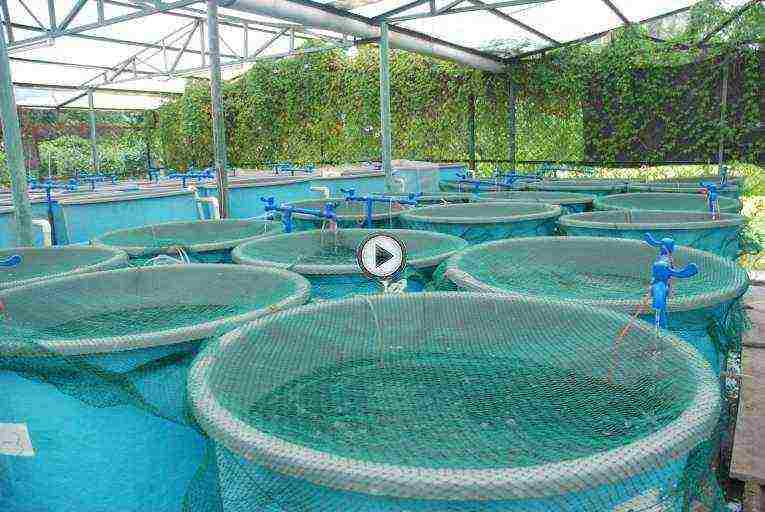
Basin cultivation method
Breeding sturgeon in the basement of a multi-storey building
What kind of fish is profitable to breed
Among the various types of fish, it is recommended to choose one that quickly gains weight, is unpretentious and resistant to diseases, and is also in demand among a wide range of the population.
Many experts advise newcomers to the fishing business to start with carp and trout, since these species are developing well and are in stable demand.
Carps quickly adapt to new conditions, are unpretentious to food, and are resistant to various diseases. Despite the low cost, the income after the sale of fish is quite high. For example, the profitability of the well-known enterprise OJSC "Biserovskiy Rybokombinat" is 9-10%.
The business plan for trout breeding is laborious and complex, since this fish is demanding and whimsical in terms of keeping conditions. For its cultivation, you cannot do without an experienced highly qualified specialist. But such advantages as an affordable breeding system, high product prices, excellent product taste, low maintenance requirements (compared to other salmonids) attract many businessmen.
Many farms breed silver carp.The advantages of this fish are that they can live peacefully with their "brothers" - grass carp and carp. Silver carp quickly gains weight, can reach up to a meter in height and 30 kilograms of weight.
Tench is an undeservedly forgotten subject of Russian fish farming. The fish gets along well with carp and crucian carp, is characterized by excellent taste. The meat is slightly sweet, tender, medium fat. Lin is resistant to many common diseases - dactylogirus, rubella, all sorts of parasites. Fish feel good in water bodies overgrown with algae with a lack of oxygen.
Related videos:
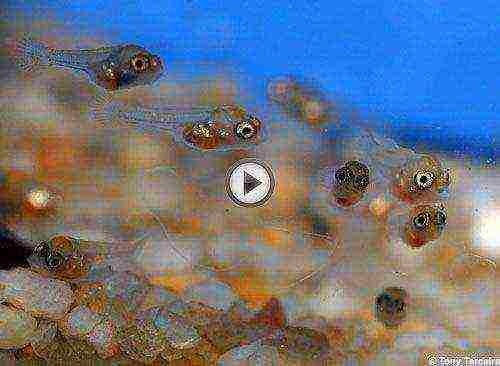
Food for fry. (Excellent food for fry of different types of fish.)
Artificial fish farming
The technology of growing fish in pools is a modern progressive version of the intensive development of aquaculture. Fish basins have been popular for decades, yet another way is to find the lowest point on your backyard, dig a pit, and build an artificial pond.
This option is beneficial, but very time consuming.
The bottom of the pond in the dacha for fish farming must be flat (holes can lead to waterlogging of the soil) and be isolated from groundwater ingress.
The insulating material can be:
- clay;
- sand;
- asbestos;
- concrete;
- expanded clay Large farms make several types of ponds:
- spawning for hatching larvae from eggs;
- fry;
- wintering;
- adrenal;
- feeding.
Related videos:
Artificial breeding of trout
Closed water supply installations
Over the past decade, a new closed water exchange technology - RAS - has appeared on the Russian market. There is no need to rent large areas of land. Modern fish farms consist of a hangar-type room, which contains several pools and equipment for water purification. The modular system of tanks allows keeping fish at a high stocking density (from 40 to 400 kg of fish per 1 m³). The feeding process is automatic. Fish in the given proportions receive dry granulated food, which enables them to gain weight and develop as quickly as possible. The water purification system directs it to all pools and removes pollution by saturating it with oxygen. This makes it possible to use water for a long time with small losses - up to 10%.
The advantages of RAS are obvious:
- refusal to discharge contaminated wastewater;
- economical use of water resources;
- the ability to grow fish and vegetables in one system and create a waste-free technology;
- ease of disposal of fish waste products;
- saving time for caring for fish;
- easy control of the dilution process - regulation of temperature, oxygen, light.
The only but significant drawback of RAS is the high cost of the system.
Related videos:
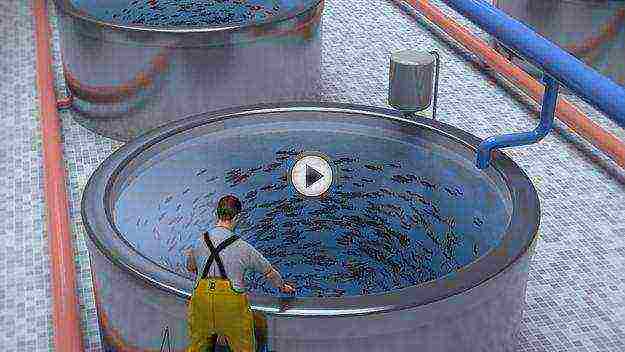
Farming fish in RAS
Basic feeding rules
For rapid growth, it is important to carefully consider the acquisition of fish seed. It is better to choose fry in fish farms. Before purchasing feed, check the manufacturer's certification, veterinary certificate and quality certification.
Successful fish processing plants use industrial feed containing protein. Despite the high cost, the weight gain is doubled compared to conventional feed.
When feeding, you must observe the measure. The fish eats everything that is poured, but the hydrochemical regime of the reservoir will be violated if the proportions are violated. This will slow down development. The rate and types of feeding depend on the type of fish, temperature regime and conditions of detention.
Related videos:
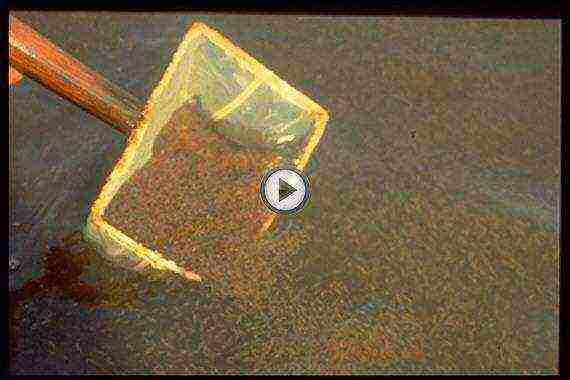
How to breed Artemia (Artemia is used as fish food in aquaculture and aquaristics.)
Business registration
The lack of domestic fish farming for sale lies in administrative barriers. It is not easy to obtain permission to rent a reservoir or part of it from local authorities, and a large package of documents is required.
But the laws of the Russian Federation do not prohibit the breeding of fish in the rate that are located on the territory of the land, which is private property. In other words, digging a pond on your own, installing a recirculating water system or pouring water into a quarry is much easier than working in a natural reservoir.
In this case, no permits are required. But stocking requires a veterinary certificate (epidemiological conclusion and fishery invoices). It is also necessary to register an individual entrepreneur or LLC with the OKVED code 05.02 "Fish farming".
Financial plan
Home-based fish farming as a business can be very profitable with proper planning and implementation of the idea. The cost of a project depends on its scale, development region, choice of fish species, technologies, etc.
If you open a mini-farm without hiring workers and saving on all aspects, the cost level will be distributed as follows:
1. purchase of fry - 300-500 rubles / kg. (when calculating, do not forget that 10% of them will not survive, and only 30-40% will be able to gain optimal weight);
2. Equipment with an artificial pool - from 6 thousand rubles. per piece;
3. purchase of feed - from 15 thousand rubles. per ton;
4. purchase of equipment for fish farming - from 50 thousand rubles.
The information provided in the article is only a brief introduction to the essence of business.
If you decide to move on to implementation, then you need to download a professional fisheries business plan with detailed calculations:
DOWNLOAD
Initial investments are from 150 thousand rubles. Add to this figure contingencies such as medical treatment. In general, fish farming is a profitable business, the main thing is to find distribution channels. It can be a restaurant, cafe and other catering establishments, as well as implementation at small or wholesale outlets.
Commercial offers
The page publishes only reviews that are useful to others, which indicate that the person had experience in this matter.
Thank you very much in advance if you share your precious experience with our readers! :)
Fish is of great importance in the human diet, it can be fry, boil, dry some types to use raw. In order to cook it, you need to get it. You can get it in different ways, buy in the market or in the store. Catch on a fishing trip or grow it yourself. Also, fish can not only be eaten, but also earned on breeding and growing. In this article, we will consider the topic of fish farming as a business, profitable or not.
Condition of fish farming as a business
The average profitability of fish farming is 20%, for the most part depends on the entrepreneur himself, his knowledge and desire to earn money.
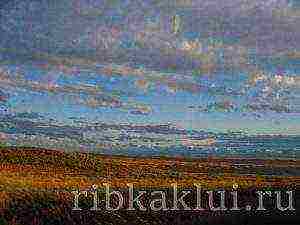 Before you start, you need to know that this business will not bring you instant profits. Under the best conditions, this can be in two to five seasons. It all depends on the growth rate and value of the breed. In order for the income to be every season, with extensive fish farming, fry will have to be launched into the pond every year, until the fry of the first year become sexually mature and begin to reproduce themselves.
Before you start, you need to know that this business will not bring you instant profits. Under the best conditions, this can be in two to five seasons. It all depends on the growth rate and value of the breed. In order for the income to be every season, with extensive fish farming, fry will have to be launched into the pond every year, until the fry of the first year become sexually mature and begin to reproduce themselves.
Semi-intensive, will require cages for each year the fry are launched. It is used as a fattening
Breeding in pools will also require rearing containers for the number of years the fish is planned to be reared.
First, let's look at the main issues of fish farming.
- The economic component of the business.
- What kind of fish to breed.
- Fish farming methods.
- Necessary activities for fish farming.
The economic component.
Carp and trout are considered the most economically profitable in terms of fish farming as a business in the CIS.
Where to begin
The action plan for the arrangement of the fishery includes several points.
- Finding out the demand for a product in the market.
- Selection of fish for breeding.
- Selection of breeding and cultivation method.
- Obtaining documents for the right to engage in fish farming.
- Purchase and arrangement of fish breeding reservoirs.
- Selection and purchase of the necessary equipment (pumps, filters, aerators, etc.).
- Purchase of fry, feed, medicines.
- Working with suppliers and sales markets.
Carp
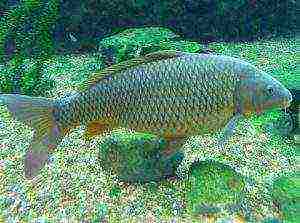 Carp, an artificially bred breed by carp selection, is easy to cross, grows quickly, is fertile, and is not whimsical to water quality and oxygen content. Able to gain weight with good feeding, even in small artificial ponds and pools.
Carp, an artificially bred breed by carp selection, is easy to cross, grows quickly, is fertile, and is not whimsical to water quality and oxygen content. Able to gain weight with good feeding, even in small artificial ponds and pools.
As in any other business, you need a business plan, which means you need to take into account all the costs and time to generate income.
The business plan includes
Initial investment.
1 hectare of a reservoir stocked with fry will require approximately 60,000-70000 rubles.
Consider what the main costs are falling on, per hectare.
- Registration of documents 10,000 (lease agreement, registration of an enterprise, call of sanitary and epidemiological supervision specialists, purchase of a license).
- Malok 17000
- Arrangement of 20,000 (purchase of the necessary equipment, cleaning of the pond and territory)
- Feed for the first month 10000
- Other expenses 3000-5000 rubles.
To begin with, we get about 62,000 rubles per hectare.
The figures are approximate, for different regions may differ.
Growing and feeding
It should be noted that some fish species, such as carp, crucian carp, catfish, sterlet, stop feeding in winter, go into wintering pits and fall into suspended animation.
For this reason, for these breeds, the cost of feeding is calculated as an arithmetic average.
Another factor is that the larger the individual, the more feed it will need.
Income for the third year of a stocked reservoir
Now let's calculate how much income we get from 1 hectare S of the reservoir. 1 ha = 100m * 100m
250 kg fry, after 3 years 2500 kg
The approximate wholesale cost of 1 kg of carp is 60 rubles.
2500 * 60 = 150,000 rubles.
150000-62000 = 88000 rubles.
It is important not to forget that sexual maturity occurs in the third year of life. By leaving a few individuals for breeding, the cost of fry can be removed. Thereby increasing the revenue side.
In the future, you can remove the cost of purchasing equipment, since it is purchased once every several years, and may only require repair costs.
Fourth year
5000 documents (rent certificates)
Construction 5000 (repair)
Other 3000
Total for 1 ha 13000
Implementation 150,000-13,000 = 137,000 rubles.
Trout
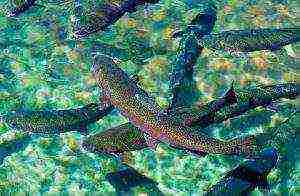 Two types of productive trout are most suitable for artificial breeding, rainbow and brook trout. The most profitable in terms of profitability is considered to be cultivation in enclosed spaces according to the principle of closed water supply installations (RAS), intensive cultivation.
Two types of productive trout are most suitable for artificial breeding, rainbow and brook trout. The most profitable in terms of profitability is considered to be cultivation in enclosed spaces according to the principle of closed water supply installations (RAS), intensive cultivation.
Establishing a trout farm requires the same activities as carp farming.
- Registration of the necessary papers 10000
- Purchase of the necessary equipment 1,500,000
- Fry 300000
- Feed 200,000
- Employee salary 300,000
- Scheduled maintenance (replacement of filters, purchase of spare parts) 200,000 rubles.
- Total RUB 2,600,000
Trout wholesale price 300 rubles. for 1 kg.
With intensive cultivation from 1 hectare, the yield is 10 tons of fish.
10,000 * 300 = 3,000,000 rubles.
3,000,000-2,600,000 = 400,000 rubles.
Sexual maturity occurs at the age of 3 years. With a competent approach to artificial insemination of eggs, an article, the purchase of fry, can be removed from the list of costs.
Income
The cost of creating a farm will pay off in three years. With established sales, starting from the fourth year, the farm will begin to receive a good income.
- Sanitary certificates and other papers 5000
- Feed 200000
- Employees 300,000
- Service 200,000
The total cost from the fourth year is 705,000 rubles.
3,000,000-705,000 = 2,295,000 rubles.
Summing up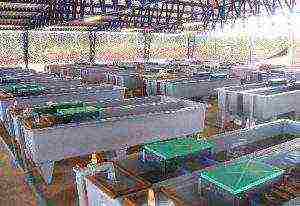
Breeding carp is easy, but the profitability is lower.
Trout farming is difficult, but the income for the same period is higher.
Necessary activities for fish farming
What to buy and do.
- Ponds or tanks for fish
- Hangar for intensive fish farming
- Communications (electricity, heating, sewerage, treatment facilities and filters).
- Pumps for circular circulation of water.
- Aerators for oxygen enrichment of water.
- Emergency generator.
- Various nets, cages, nurseries.
- Occupation area code OKVED 03.2.
- Necessary papers for an artificial reservoir
- Registration of an individual entrepreneur or LLC. Passport, copy of ind, payment of duties.
Permissions
- Veterinary certificate from the sanitary epidemiological authority.
- Registration at the fish inspection.
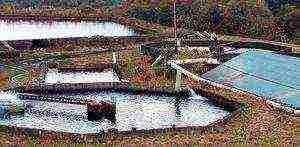 The fish farming and growing business is now becoming more and more attractive for entrepreneurs in Russia.For many breeders, this is also an activity for the soul, the joy of being in nature, calm contemplation of a pacifying water surface, merrily splashing fish, and it is not for nothing that fishing is an ancient traditional occupation of a man. As a result of the efforts made, you can get a tasty and healthy product, as well as valuable raw materials for processing and manufacturing various culinary products.
The fish farming and growing business is now becoming more and more attractive for entrepreneurs in Russia.For many breeders, this is also an activity for the soul, the joy of being in nature, calm contemplation of a pacifying water surface, merrily splashing fish, and it is not for nothing that fishing is an ancient traditional occupation of a man. As a result of the efforts made, you can get a tasty and healthy product, as well as valuable raw materials for processing and manufacturing various culinary products.
Dear Readers! The article talks about typical ways of solving legal issues, but each case is individual. If you want to know how solve your problem - contact a consultant:
(Moscow)
(St. Petersburg)
(Regions)
It's fast and is free!
Prospects for the development of fisheries
The fish farming business is promising occupation, because the:
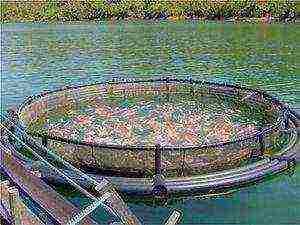 Fish products are a common diet in the menu of Russians, including during religious fasts, and the basis for the preparation of many types of dishes. In addition, this is food not only with excellent taste, but also rich in easily digestible protein, trace elements, vitamins, and valuable fish oil.
Fish products are a common diet in the menu of Russians, including during religious fasts, and the basis for the preparation of many types of dishes. In addition, this is food not only with excellent taste, but also rich in easily digestible protein, trace elements, vitamins, and valuable fish oil.- There is a steady stable demand for fish among the population, especially today, when, as a result of the economic processes of import substitution, the range of fish products in stores has noticeably decreased.
- Fish stocks in the natural environment are limited, every year they become less and less, therefore the relevance of the maintenance of fish farms is increasing.
- The organization of a business in itself, with a ready-made pond and the use of a natural fish feeding regime, can be simple and require minimal investment.
- Fish farming as a business can be combined with additional sources of income associated with this industry - the organization of processing fish raw materials, paid fishing services, recreation on the shore of the reservoir, where you can also organize places for the night, a mini-snack with various fish dishes (salted, dried , smoked, fried, canned fish).
The nuances and complexities of this business
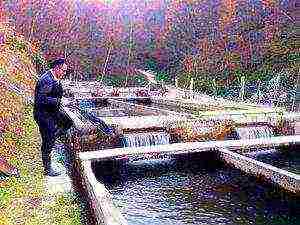 Despite all the obvious advantages of making a profit from fisheries, it is necessary to designate and possible difficultiesthat will accompany the conduct of this business:
Despite all the obvious advantages of making a profit from fisheries, it is necessary to designate and possible difficultiesthat will accompany the conduct of this business:
- Relatively low profitability of this type of production, about 10-20%. It can be slightly increased due to the accelerated fish farming cycle and the formation of stable demand for products. Unfortunately, many fish breeders in our country admit that because of the crisis it is more profitable to resell already grown fish than to start the whole cycle from scratch.
- A solid investment and a long payback period of the project - about 2-3 years, depending on the type of fish. An additional nuance is the seasonality of the sale of products for open reservoirs - as a rule, the autumn period. Whereas the rest of the time the business will only require cash investments, mainly for feed.
- The risk of reduction or destruction of the fish population in the farm due to non-compliance with the basic conditions of detention, malnutrition and the resulting diseases of individuals. Fish is quite sensitive to external conditions, therefore, the owners of reservoirs should strictly follow all the rules for its cultivation.
- Difficulties may arise at the stage of registration of permits for opening this type of business.
In order to neutralize all possible risks, it is recommended to carefully study all the literature on this issue before starting your own fish farming business, perhaps attend specialized courses, make excursions to successful fish farms in order to gain the necessary experience.
A competent detailed business plan for the maintenance of the fish farm is required.
If you have not registered an organization yet, then
easiest this can be done using online services that will help you generate all the necessary documents for free:
- for registration of individual entrepreneurs
- registration of LLC
If you already have an organization, and you are thinking about how to facilitate and automate accounting and reporting, then the following online services come to the rescue, which will completely replace the accountant in your company and save a lot of money and time. All reports are generated automatically, signed with an electronic signature and sent automatically online.
- Accounting for individual entrepreneurs
- Accounting for LLC
It is ideal for an individual entrepreneur or LLC on
USNENVDPSNTS
, OSNO.
Everything happens in a few clicks, without queues and stress.
Try it and you will be surprised how easy it became!
Organizational moments
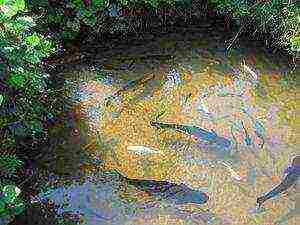 It is permissible to register a fish farming business in the status of an individual entrepreneur or an LLC, depending on the volume of production. However, it should be borne in mind that large companies, when cooperating, still trust legal entities more.
It is permissible to register a fish farming business in the status of an individual entrepreneur or an LLC, depending on the volume of production. However, it should be borne in mind that large companies, when cooperating, still trust legal entities more.
First you should choose breeding pond fish. This can be a natural or artificial pond, a specially created pool with a closed water supply installation, or a technology for growing fish in cages. Then it is necessary, through a marketing analysis of the local market, to decide on the type of fish being launched and the required production volumes. This is followed by the procedure for registering a purchased or rented reservoir and obtaining mandatory permits.
A permit to organize a fish farming business is taken from the local government bodies in charge of the territory of the pond, from the State Committee for Fisheries (permit for catching fish), and from the State Committee for Water Resources (control of water resources). It may be required to conduct an environmental impact assessment and obtain permission from the Ministry of Emergencies. Also, in order to carry out entrepreneurial activities related to the sale of fish or the organization of paid fishing, it is necessary to obtain certificates of the sanitary and epidemiological station.
When choosing sources of funding, it should be understood that a businessman will be able to receive his first income no earlier than 2 years after opening a business. Therefore, raising borrowed funds in the form of a loan for a small business may be unprofitable. Here, the preferred ways will be: the availability of own funds, the search for an interested investor, or government subsidies for the development of aquaculture as an agricultural sector.
Choosing an affordable and profitable type of fish
The greatest demand among buyers is the following types of fish:
- Carp family - carp, crucian carp, tench, bream, silver carp;
- Salmon family - trout, salmon, salmon, pink salmon.
The most profitable options for raising fish in a commercial volume in terms of the ratio of costs, conditions of keeping and the expected profit are carp and trout. Weight of adult carp: 1.2-1.7 kg, trout: 0.8-1 kg. Before reaching such a mass, carp grows for 3 years, trout for 2.5 years. The most popular types of carp are scaly, naked, mirror, trout - river, rainbow.
Fish breeders advise buying already grown fry for about 4 months, since removing fish from eggs, that is, growing it from the very beginning, can be very costly and risky. It is better to take planting material for reservoirs at proven fish factories.
An example of organizing a trout breeding business is discussed in this video:
Thinking over the place of sale of products
Implementation of the obtained fish products depends on the volume and is possible in the following ways:
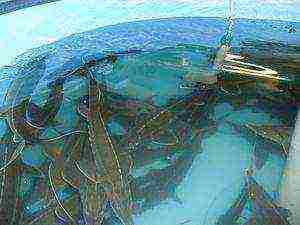 Through the network of specialized fish stores;
Through the network of specialized fish stores;- In food markets;
- In the fish departments of large supermarkets;
- In stalls, kiosks, from a fish car;
- By delivery to canteens, cafes, restaurants;
- In the form of selling raw materials for fish processing enterprises;
- Through wholesale resellers;
- Through online commerce.
For the sale of fish through grocery stores and supermarkets, a supply agreement will be required. It is possible to install a mini-pool with live fish in supermarkets to advertise products, but stores are reluctant to do this. It should be remembered that there is competition in this type of business, that the purchase of fish is not available to all potential buyers due to the high price of the product. In addition, the money for the fish sold is received only upon its sale, that is, payments are delayed.
Pond preparation
The main directions of fish farming:
- Pond farming (natural or artificial) - suitable for raising many types of fish.
- Basin breeding with a recirculated water system - may also work for most fish species.
- Breeding fish in cages, large barrels, tubs is acceptable for large breeds.
The best location for the reservoir will be the countryside; even your own land plot or summer cottage will do. There must be access roads to the reservoir. An advantageous location will be the presence of a nearby settlement for an established sales system.
 For the development of fish to take place in the correct way, the reservoir must correspond certain parameters:
For the development of fish to take place in the correct way, the reservoir must correspond certain parameters:
- a place that is not too elevated, but not low, is suitable to exclude the consequences of a flood;
- one of the sections of the pond must necessarily fall into partial shade to avoid overheating of the fish;
- a small number of trees are permissible around the reservoir, since the roots can deform the reservoir, and in the fall the leaves will clog the pond;
- the optimal pond size for a mini-fish farm is 30-50 sq. m;
- the depth of the pool or pond is at least 1.5 m;
- a clean bottom without peat or silt is necessary;
- breeding different fish will require a variety of soil;
- the vegetation of the reservoir is justified in moderation;
- the bottom topography should be complex: with alternating deep water and shallow water, with rapids and ledges of various sizes;
- in winter, a layer of unfrozen water of about 1 m is required in the pond. Ice-holes are made in the thickness of the ice, covered with straw so that the fish does not suffocate. You can also freeze a bundle of reeds vertically into the ice for the same purpose.
The reservoir will be used for keeping fish, raising it, selecting eggs and incubating the young. In large developed farms, several types of reservoirs are arranged: spawning pond, rearing pond, feeding pond, wintering pond. Periodic cleaning of the pond from fish waste products is imperative. It is less productive than fish farming in pools, but it is convenient for landowners.
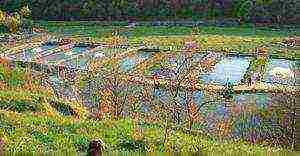 Artificial pond it is made according to a special technology of a rounded shape, the soil at the bottom is compacted, it is cemented. A plastic film is placed on the bottom, water is started up to about 1/3, then a layer of soil or river sand is placed and underwater plants are planted. After that, all the water is added. For some time, the pond stands without fish, so that the water reaches its natural temperature and its own environment of microorganisms appears. It is recommended to fill up a few buckets from a natural reservoir so that the water quickly becomes "alive".
Artificial pond it is made according to a special technology of a rounded shape, the soil at the bottom is compacted, it is cemented. A plastic film is placed on the bottom, water is started up to about 1/3, then a layer of soil or river sand is placed and underwater plants are planted. After that, all the water is added. For some time, the pond stands without fish, so that the water reaches its natural temperature and its own environment of microorganisms appears. It is recommended to fill up a few buckets from a natural reservoir so that the water quickly becomes "alive".
Pond size in depth should be at least 1.5 m, and in area - at the rate of at least 10-15 cm in length per individual. There are some nuances here: it is better for fish to winter with great depth, but in summer such a reservoir will warm up unevenly. A shallow pool with a large surface absorbs more oxygen, which is beneficial for fish. Before the first start, it is necessary to equalize the temperature in the pond and in the portable container with fish so that there is no temperature shock. In the future, purification and aeration of water, control of vegetation on the water surface will be required.
Fish farming in basins with recirculating water (installation of a closed water supply) requires certain costs, but this is a promising option. Their cost is high, but the density of fish in them is also the highest.For normal development, water must be continuously purified and enriched with oxygen. Fish grows rather quickly in RAS, for example, trout reaches the marketable weight after 2 years.
For installation cages containers welded from sheet iron are required. They can be purchased ready-made or made yourself. The cages must be covered so that the birds do not catch most of the young fish.
Thus, the type of reservoir can be any, the main thing is to create comfortable conditions for keeping fish.
Selection and purchase of suitable equipment
Necessary equipment for fish farming includes:
- gravity filter - protects water from bloom and pollution;
- compressor (aerator) - will not let the fish die from lack of air;
- ultraviolet sterilizer - eliminates water bloom in the pond;
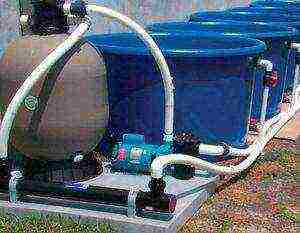 hydraulic pump - helps to pump water into an artificial pool;
hydraulic pump - helps to pump water into an artificial pool;- generator, uninterruptible power supply in the event of a power outage;
- feeding troughs, including automatic;
- water condition analyzers;
- various devices for catching fish (nets, nets, etc.).
There are both domestically produced devices and their foreign counterparts on the market. Today, preference is given mainly to Russian manufacturers due to budget savings.
Organization of an appropriate water climate for fish
The temperature of the water, its acidity, as well as the oxygen content in it, determine the health and growth of fish. Also an important condition is the purity of the water, the absence of mechanical and chemical impurities in it.
Climatic conditions for keeping different fish species may vary. So, warm water (24-26 degrees) is best for carp, and cooler water (16-19 degrees) for trout. To maintain such conditions, carp can be kept at a depth of 1.5-2 m, and trout - up to 15 m, respectively. A deviation of the temperature column in one direction or another may threaten a deterioration in the condition of the fish.
A prerequisite fish farming is the periodic filtration of water, its aeration. Under optimal conditions, fish will grow faster, which is very important for business.
Fish farming technology
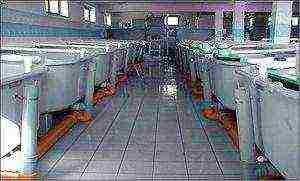 Each fish breed has its own peculiarities of breeding, which must be taken into account in business planning. At the same time, 1-2 workers are capable of servicing a mini-fish farm.
Each fish breed has its own peculiarities of breeding, which must be taken into account in business planning. At the same time, 1-2 workers are capable of servicing a mini-fish farm.
Use two basic technologies fish farming:
- Traditional - consists of step-by-step actions for fish growing, as a rule, this is a 2-3-year cycle. Each technological operation is carried out in a special pond, upon completion of which the water must be drained. The fish is transplanted several times, which is very laborious and associated with population losses.
- Continuous - provides for the rearing of young stock up to a weight of 1-1.5 kg and the further maintenance of fish without replanting. Only two ponds are required: one for fry and one for feeding. This technology is less labor intensive and more in demand.
Also fish can be grown intensive and extensive methods:
- When intensive, the fish receives special feed in addition to the natural one. The productivity of the farm will be the highest here.
- When extensive, the fish consumes natural food without special supplementation. This method requires minimal investment.
Regardless of the technology chosen and the method of fish breeding, it is important to remember that in the reservoir you should maintain constant purity and flow of water, make its technical aeration, liming to regulate acidity. The fish has time to gain the required marketable mass in about 2-3 years. The growth and productivity, reproduction, health of fish depend on the conditions of maintenance, the quality of water, food and the climatic zone in which the farm is located. Periodically (every 10 days) it is necessary to inspect the fish, give medicinal additives for prophylaxis.
The technology using RAS is discussed in the following video:
Feeding rules
Nutrition efficiency depends on the biological characteristics of a particular fish species, nutritional needs, opportunities for their growth and development, and is also associated with environmental conditions. The food differs in composition and useful properties not only for each breed, but also for adults and young animals within the same species. The energy requirements of fish are relatively low.
Despite the fact that the purchase of feed is the main cost item in the fisheries - 50-60%, it is important use only high quality feedwhich significantly accelerate the growth of fish. Protein-rich foods are especially needed. A gain of 1 kg is provided by 4 kg of feed. For comparison: from a reservoir of 1 hectare you can get fish products - 0.3 tons per year with natural feeding and 1.2 tons - with intensive feeding.
 Necessary components of a complete feed for fish:
Necessary components of a complete feed for fish:
- amino acids to maintain appetite and favorable growth rates, especially for fry;
- vegetable and animal fats for the growth and health of the body;
- fiber - for trout - 20%, for carp - at least 40%;
- biologically active substances: premixes and enzyme preparations;
- forage of plant origin - mixtures of cereals, including bran, which provide carbohydrates and B vitamins;
- animal feed: meat and bone and krill meal;
- dairy products for young animals: dry return, dry milk;
- medicinal food to improve immunity.
For all fish species, feed in the form of a mixture of cereals and legumes, which is steamed to swell for feeding, is suitable. The volume is not more than 3-6% of the mass of the fish, it is important to observe the measure here. Meals are given 1-2 times a day at the same time in a certain place in the pond. To do this, you can use special feeders: pallet tables to keep track of how much feed has been eaten. Before feeding, you can ring the bell to attract fish.
Financial part
To organize fish farming, you will need initial investment from 500 thousand to 1 million rubles (depending on the size of the reservoir), which includes the purchase (or lease) and improvement of the pond (pool), the installation of cages (if provided by the technology), the purchase and installation of the necessary equipment, business registration and obtaining permits ...
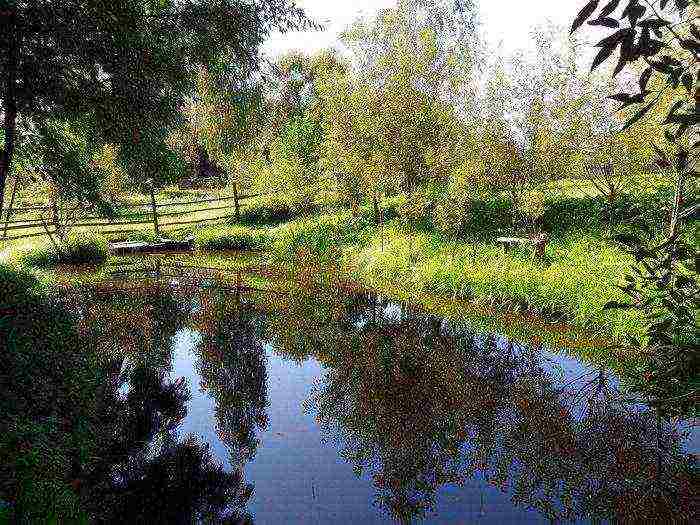 Main costs:
Main costs:
- Purchase of planting material (fry): 10-50 thousand rubles.
- Purchase of feed: 10-50 thousand rubles.
- Personnel salary: 30-50 thousand rubles.
- Other costs (transport, utilities): 20-30 thousand rubles.
Total profit (excluding taxes) approximately: 200-300 thousand rubles.
Payback period: 2-2.5 years depending on the type of fish and the method of growing.
Additional income can be obtained from the organization of paid fishing and recreation near the pond - up to 10% of the total profit of the fish farm, as well as from the processing of fish raw materials, the manufacture of canned food and various types of fish products.
How to grow carp at home is described in the following video:
Still have questions? Find out how to solve exactly your problem - call right now:
(Moscow)
(St. Petersburg)
(Regions)
It's fast and is free!













 Before you start, you need to know that this business will not bring you instant profits. Under the best conditions, this can be in two to five seasons. It all depends on the growth rate and value of the breed. In order for the income to be every season, with extensive fish farming, fry will have to be launched into the pond every year, until the fry of the first year become sexually mature and begin to reproduce themselves.
Before you start, you need to know that this business will not bring you instant profits. Under the best conditions, this can be in two to five seasons. It all depends on the growth rate and value of the breed. In order for the income to be every season, with extensive fish farming, fry will have to be launched into the pond every year, until the fry of the first year become sexually mature and begin to reproduce themselves. Carp, an artificially bred breed by carp selection, is easy to cross, grows quickly, is fertile, and is not whimsical to water quality and oxygen content. Able to gain weight with good feeding, even in small artificial ponds and pools.
Carp, an artificially bred breed by carp selection, is easy to cross, grows quickly, is fertile, and is not whimsical to water quality and oxygen content. Able to gain weight with good feeding, even in small artificial ponds and pools. Two types of productive trout are most suitable for artificial breeding, rainbow and brook trout. The most profitable in terms of profitability is considered to be cultivation in enclosed spaces according to the principle of closed water supply installations (RAS), intensive cultivation.
Two types of productive trout are most suitable for artificial breeding, rainbow and brook trout. The most profitable in terms of profitability is considered to be cultivation in enclosed spaces according to the principle of closed water supply installations (RAS), intensive cultivation.
 The fish farming and growing business is now becoming more and more attractive for entrepreneurs in Russia.For many breeders, this is also an activity for the soul, the joy of being in nature, calm contemplation of a pacifying water surface, merrily splashing fish, and it is not for nothing that fishing is an ancient traditional occupation of a man. As a result of the efforts made, you can get a tasty and healthy product, as well as valuable raw materials for processing and manufacturing various culinary products.
The fish farming and growing business is now becoming more and more attractive for entrepreneurs in Russia.For many breeders, this is also an activity for the soul, the joy of being in nature, calm contemplation of a pacifying water surface, merrily splashing fish, and it is not for nothing that fishing is an ancient traditional occupation of a man. As a result of the efforts made, you can get a tasty and healthy product, as well as valuable raw materials for processing and manufacturing various culinary products. Fish products are a common diet in the menu of Russians, including during religious fasts, and the basis for the preparation of many types of dishes. In addition, this is food not only with excellent taste, but also rich in easily digestible protein, trace elements, vitamins, and valuable fish oil.
Fish products are a common diet in the menu of Russians, including during religious fasts, and the basis for the preparation of many types of dishes. In addition, this is food not only with excellent taste, but also rich in easily digestible protein, trace elements, vitamins, and valuable fish oil. Despite all the obvious advantages of making a profit from fisheries, it is necessary to designate and possible difficultiesthat will accompany the conduct of this business:
Despite all the obvious advantages of making a profit from fisheries, it is necessary to designate and possible difficultiesthat will accompany the conduct of this business: It is permissible to register a fish farming business in the status of an individual entrepreneur or an LLC, depending on the volume of production. However, it should be borne in mind that large companies, when cooperating, still trust legal entities more.
It is permissible to register a fish farming business in the status of an individual entrepreneur or an LLC, depending on the volume of production. However, it should be borne in mind that large companies, when cooperating, still trust legal entities more.
 Through the network of specialized fish stores;
Through the network of specialized fish stores; For the development of fish to take place in the correct way, the reservoir must correspond certain parameters:
For the development of fish to take place in the correct way, the reservoir must correspond certain parameters: Artificial pond it is made according to a special technology of a rounded shape, the soil at the bottom is compacted, it is cemented. A plastic film is placed on the bottom, water is started up to about 1/3, then a layer of soil or river sand is placed and underwater plants are planted. After that, all the water is added. For some time, the pond stands without fish, so that the water reaches its natural temperature and its own environment of microorganisms appears. It is recommended to fill up a few buckets from a natural reservoir so that the water quickly becomes "alive".
Artificial pond it is made according to a special technology of a rounded shape, the soil at the bottom is compacted, it is cemented. A plastic film is placed on the bottom, water is started up to about 1/3, then a layer of soil or river sand is placed and underwater plants are planted. After that, all the water is added. For some time, the pond stands without fish, so that the water reaches its natural temperature and its own environment of microorganisms appears. It is recommended to fill up a few buckets from a natural reservoir so that the water quickly becomes "alive". hydraulic pump - helps to pump water into an artificial pool;
hydraulic pump - helps to pump water into an artificial pool; Each fish breed has its own peculiarities of breeding, which must be taken into account in business planning. At the same time, 1-2 workers are capable of servicing a mini-fish farm.
Each fish breed has its own peculiarities of breeding, which must be taken into account in business planning. At the same time, 1-2 workers are capable of servicing a mini-fish farm. Necessary components of a complete feed for fish:
Necessary components of a complete feed for fish: Main costs:
Main costs: